The Royal Company of Merchants of The City of Edinburgh
Our History
The Royal Company of Merchants of the City of Edinburgh has a rich history interwoven with the fabric of Edinburgh life which can be traced back to at least the year 1260. The Company received it's Royal Charter in 1681.
In its early days, the Company concerned itself with such matters as the city water supply and expressed regret that too many trading premises were being turned into ‘brandy shops’ or ‘tippling places’. However, eventually the status and influence of Members was seen by public-spirited benefactors as an efficient and perpetual means of putting into effect their last wills and testaments and, as a result, charitable trusts were left to the Company to administer.
This, coupled with shrewd investment, resulted in the Company becoming one of the biggest landowners in Scotland. For example, until recently one of the Master’s responsibilities was that of the Chairman of the Trustees of the Harbours of Peterhead and Chairman of the Managers of the Feuars of Peterhead.
It also saw the Company assuming many responsibilities, relating mainly to the young, the poor and the elderly. In 1694, Mary Erskine, possibly the widow of a Company Member, gave over 10,000 mercs for the “maintenance of burgess female children” which established the Mary Erskine School. Further legacies resulted in the opening of George Watson’s College in 1741, Daniel Stewart’s College in 1855 and James Gillespie’s High School. James Gillespie’s was handed over to the management of the Edinburgh School Board in 1908.
As time passed, the focus of the Company moved completely to education and charitable works.
The Merchants’ Hall
Since the Company came into being, it has had three principal homes: the first in the Cowgate; the second in Hunter Square; and the current Merchants’ Hall in Hanover Street. However, there were times when the Company met in various coffee houses in the city when it was without a permanent home.
Cowgate
When the Royal Charter empowered the Company to acquire a Hall of its own, it took almost 10 years for that to happen, with the purchase of “the Great Lodging, Yard and waste ground lying in the Cowgate which lately belonged to the Viscount of Oxenford and to Andrew Crawford, Sheriff of Linlithgow”.
Although no longer there, old maps show this area as a street of large houses with pleasant gardens, where the nobility had resided in the days of the Royal Court. It was best known as the residence of “Tam o’ the Cowgate” – James VI’s Secretary of State, Thomas Hamilton, Earl of Haddington.
The Company was based there for 30 years but then looked for a more prominent and convenient location in a better area. The association with the Company is reflected today in the name of Merchant Street closeby.
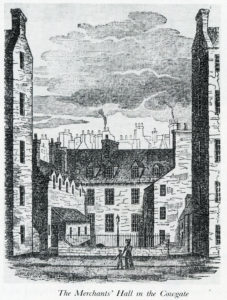
The Merchants' Hall in the Cowgate
Hunter Square
In 1788, the Company took steps to provide itself with its first purpose-built Hall, situated on the west side of Hunter Square, near the Tron Church. The first tender was for £2,200 – but the final cost was for £4,843.
The first meeting took place there in 1790. The building was further enlarged in 1825 and provision made for the Lord High Commissioner to the General Assembly to use the Hall for receptions. The Company remained there until 1879. The Hunter Square building remains to this day and is currently in use as a bar and offices.
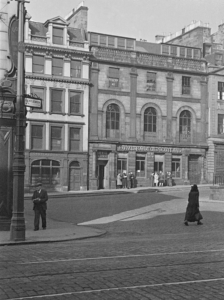
The Second Merchants' Hall in Hunter Square © RCAHMS
Hanover Street
In 1879 the Glasgow Bank failed and its offices came on to the market at 22 Hanover Street and were purchased by the Company. Over the years, whilst the original façade remains (it is a listed structure of special architectural and historical interest), it has been renovated extensively internally to suit the Company’s changing needs.
However, in the Secretary & Chamberlain’s room, there remains a link with Hunter Square Merchants’ Hall – the decorative mantelpiece was brought from there, with its main feature a representation of the sailing ship so important in the Company coat of arms.
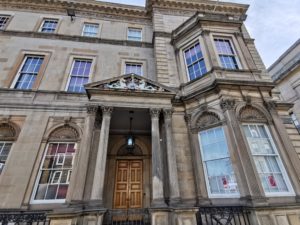
The current Merchants' Hall on Hanover Street
Our School Founders
The Merchant Company has been fortunate to have had the support of a number of well-known Edinburgh merchants and their families who took a genuine interest in the education and wellbeing of the city’s citizens. As a result, the Company was bequeathed monies from Mary Erskine, George Watson, Daniel Stewart, John Watson and James Gillespie to build schools, hospitals and accommodation for the elderly, amongst other things.
Mary Erskine
The Merchant Company proposed to establish a foundation for the education of daughters of the burgesses. As a result Mary Erskine, widow of an Edinburgh apothecary, donated money to found The Mary Erskine School in 1694, known initially as the Merchant Maiden Hospital.
The Mary Erskine School is one of the oldest girls’ schools in the world and continues to flourish today as Scotland’s premier school for girls. The penultimate Act of the 1707 Scottish Parliament was to confirm the school’s constitution.
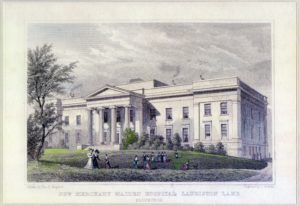
The Merchant Maiden Hospital at Lauriston
George Watson
In 1741 George Watson’s College for Boys was opened as a charitable hospital – the “hospital” system was used to educate destitute boys at that time – by the Merchant Company from the bequest of a successful Edinburgh merchant and financier, George Watson. In 1871 a girls’ school, George Watson’s Ladies’ College was founded as the Merchant Company schools grew in popularity and demand increased.
The two schools merged in 1974 to create the co-educational school at Colinton Road.
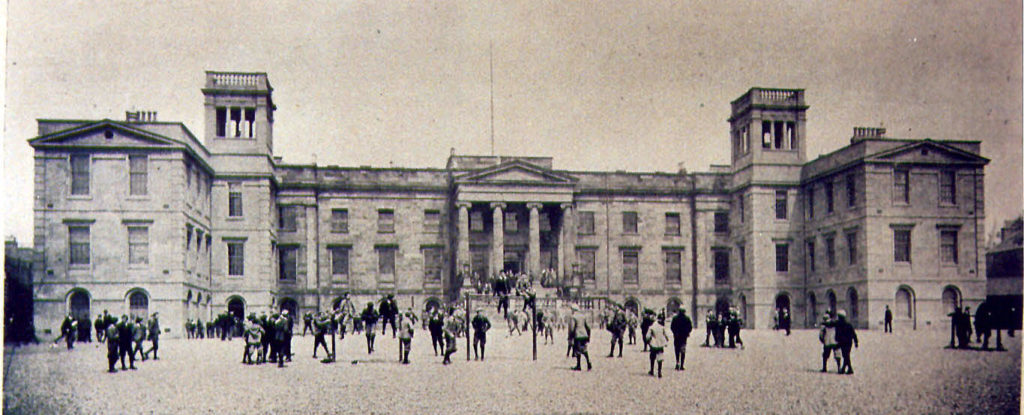 George Watson's Hospital off Archibald Place
George Watson's Hospital off Archibald Place
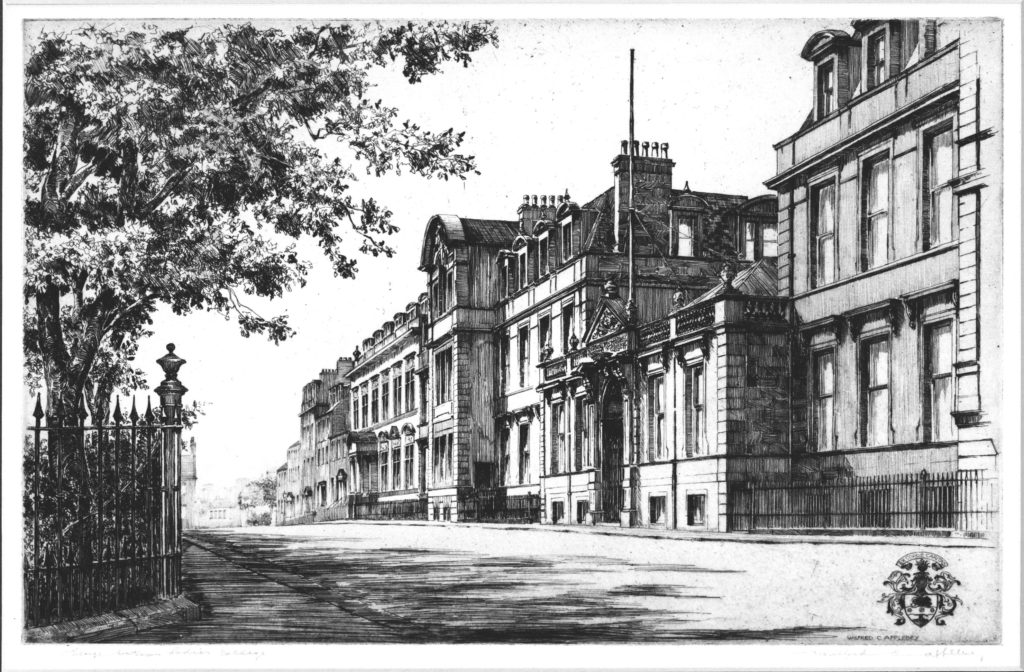 George Watson's Ladies College on George Square
George Watson's Ladies College on George Square
John Watson
Quite separately from George Watson, John Watson, an Edinburgh solicitor and Writer to the Signet, left the residue of his estate – around £2,000, for charitable purposes for children in the Edinburgh area ‘for the purpose of preventing child murder by founding an Hospital within the City of Edinburgh…’. A refuge or hostel was established which eventually became the John Watson’s School in Belford Road. The school was closed in 1975 and the buildings were purchased to house the Scottish National Gallery of Modern Art. The name was incorporated into George Watson’s College, to which a number of pupils transferred.
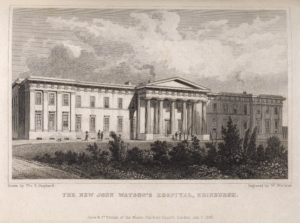
John Watson's School 1830
Daniel Stewart
Daniel Stewart’s College stemmed from the bequest of Daniel Stewart who was born in Logierait, Perthshire in 1741, the son of a poor farming family. Having moved to Edinburgh, he became a wig maker’s apprentice but through careful investment he left, on his death in 1814, a substantial sum of money for the foundation of a school for orphan and destitute boys. He entrusted its “perpetual management” to the Merchant Company of the City of Edinburgh.
Robert Cunningham
Robert Cunningham was the Founder of the Edinburgh Institution, which became Melville College. A graduate of Edinburgh University he developed a reputation as a forward-thinking educationalist which led to him becoming Headmaster of George Watson’s. He left to set up the new Institution that would follow the broad-based curriculum he had devised. In 1932 it changed its name to Melville College. In 1973 Melville merged with Daniel Stewart’s and is now part of ESMS.
James Gillespie
James Gillespie and his brother, John, were snuff merchants in Edinburgh. When he died in 1797 he left his estate, worth £40,000 together with funds to establish a charitable home for men and women, and a free school for the education of poor boys to the Merchant Company. James Gillespie’s Hospital for the elderly opened in 1801, the free school in 1803. The latter is not listed amongst the present-day Merchant Schools because in 1908 the Governors decided to transfer it to the School Board of Edinburgh. The picturesque cottages in Spylaw Street, Colinton, part of James Gillespie’s original estate, are for the elderly.
